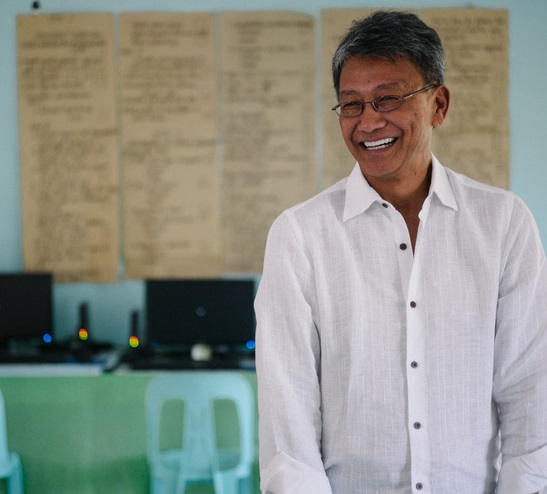The FilAms of Silicon Valley: Surviving the layoffs; the rise of Dado Banatao (Part 2)

Dado Banatao who is often called the Philippines’ Bill Gates. He founded the Philippine Development Foundation in 2000 which seeks to eradicate poverty through education, innovation and entrepreneurship, stressing the importance of science & technology in schools. Photo: PhilDev
Edwin’s wife, Josefina or Jing, was also a tech writer but followed the path into software. She has a Psychology degree and is no more an engineer than Edwin.
She started as a recruitment receptionist for Xerox when she joined Edwin from Washington DC in 1984. That meant, “All I did was read resumes, compare them with our openings and screen initial applicants. Back then, everything was in paper, no scanners, no apps.”
But unlike Edwin, she landed on a big opportunity. “At that time, Xerox was one of the few companies that pioneered the Internet. Internet was limited to the military, education and private companies like IBM. They worked together to develop a protocol called TCP/IP (Transmission Control Protocol/Internet Protocol). Xerox PARC was one of the solid contributors.
By 1985, Dado Banatao’s second company developed a system logic set for IBM’s early PCs. The Filipino community and the world would hear more about him. In four years, his S3 Graphics would enhance the graphics in computers.
Banatao is purportedly the Philippines’ Bill Gates also because of his foundations and scholarships. By his charities alone, he has done more to encourage Filipino engineering students. Dennis Fernandez, a patent attorney and one of the first venture capitalists to set up in the Philippines, once said, “Dado is the last man standing in semiconductor.”
Banatao’s staunch support of the Philippines’ efforts to upgrade technology and economy was demonstrated at a Philippine Consulate business conference in the early 2000s. A Chinese entrepreneur asked if there was still corruption in the Philippines. Of course, the consular staff was too diplomatic. But so was Banatao who nonchalantly replied, “You should be worried about China where corruption is more casual.”
Unfortunately for Jing, this was also the year of lay-offs. Being at the bottom of the totem pole, she was a prime candidate. She jumped to a low-level technician position. She wanted to stay in the company because she wanted to be exposed to network or engineering services, or what we now call IT.
It was the first time she joined an engineering group and the first time her writing skills became useful. “Only a few companies had e-mail like us. But we can only email within Xerox.”
Her writing opus would be sent out over the campus (what high-tech companies call their complexes in their conceit, calling themselves school or place of learning). It would consist of notification of data back-ups to start and when the system is back on again. “People needed to be told they won’t be able to access their files or when they must log back on.
“That was when the tech pubs (technical publication) manager noticed me.” Jing was offered a junior writer position. “That was a time when engineers looked down at tech writers because writers were seen to know nothing. So it was intimidating.”
But Jing was trained on how to do cabling and networking. Then she trained people at different work stations. Xerox put her into a tech writing certificate course at De Anza College in Cupertino. Combined with product knowledge and industry experience, Jing was helping teach procedures. Jing pressed her advantage and pursued programming although, admittedly, she was no good at it. Anyway, she could ask different engineers. This was a time when DOS was barely making its way around.
Things to come
Outside Xerox, you would be at the cutting edge if you processed in WordStar (no WordPerfect yet). But Jing said, “We had our own Xerox workstation and a very nice word processing application that Apple stole. We had the icons, the mouse pointer. Xerox Palo Alto Research Center contributed a lot to the beginning of Silicon Valley in terms of people, talent and technology. This was the time they tried to attract Steve Jobs over. But word out there is he stole ideas. Xerox never filed for a case. Later, Windows would roll out their icon design. Jobs complained but people told him he stole it from Xerox anyway.”
Jing is full of vignettes like that. She can even point out the old 6-story Apple building next to the Light Railway station on Bascom and Hamilton in Campbell. She also worked for the Versatec division of Xerox that made dot matrix plotters and copiers. “Software was required to convert different graphic formats into raster (or dot matrix data image of a rectangular grid of pixels or points of color that can be viewed on paper or monitor). This was on the network so we also requested documentation and make it recognizable with other systems that can talk to it. I was good at this because I was a network tech.”
Then she got to the same fork in the road that defined Edwin’s life. “I chose software over hardware because my boss said software kept changing even at the last minute. It would mean job security and she was right.”
Jing said they had as much as 18 tech writers at Versatec. In today’s downsized situations that could possibly done by one contractor with tools on-line and off-site meeting only once a week at the site.
Jing survived the early 1990s. By then she worked with smaller groups of writers and then built her own department from the ground up at a couple of companies.
Also, in the early 1990s, Edwin and Jing were invited to a career night for an east side high school. Professionals from all walks of life would speak before the students about their jobs. Edwin and Jing were thrown together with the history writers and the media reporters. When Jing showed the students a formatted technical document, she had to explain why she didn’t have a byline. But when she told them tech writers make good money, it sparked some interest. It was obvious nobody knew anything about tech writers.
Harvey Barkin was a Senior Buyer then Tech Writer in Silicon Valley in the 1980s. He wrote book reviews for Small Press, Rhode Island, then Independent Publisher, Michigan, in the 1990s. He has contributed to many FilAm publications mostly in California. He received the Plaridel Award in 2013 for In-depth Investigative Reporting.
Next: Where are the Filipinos in high-tech?
Part 1: The FilAms of Silicon Valley: They are not all techies
The FilAm’s Investigative Reporting Project is made possible through the generous support of our readers and contributors including the following:
Consuelo Almonte
Melissa Alviar
Amauteurish.com
Bessie Badilla
Sheila Coronel
Joyce and Arman David
Menchu de Luna Sanchez
Kathleen Dijamco
Jen Furer
Marietta Geraldino
Dennis Josue
Lito Katigbak
Rich Kiamco
Monica Lunot-Kuker
Michael Nierva
Lisa Esperame Nohs
Cecilia Ochoa
Rene & Veana Pastor
John Rudolph
Roberto Villanueva
2 anonymous donors














[…] The FilAms of Silicon Valley: Surviving the layoffs; the rise of Dado Banatao (Part 2) […]
Interesting story.